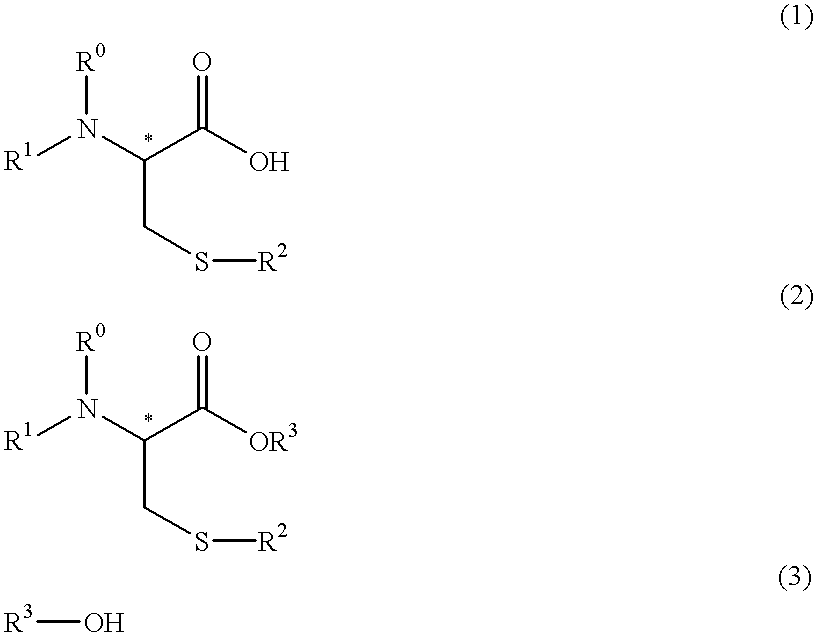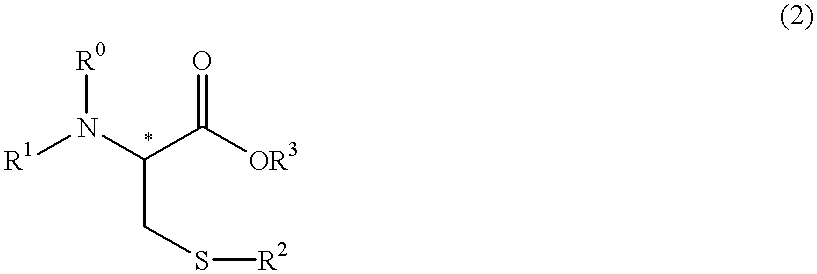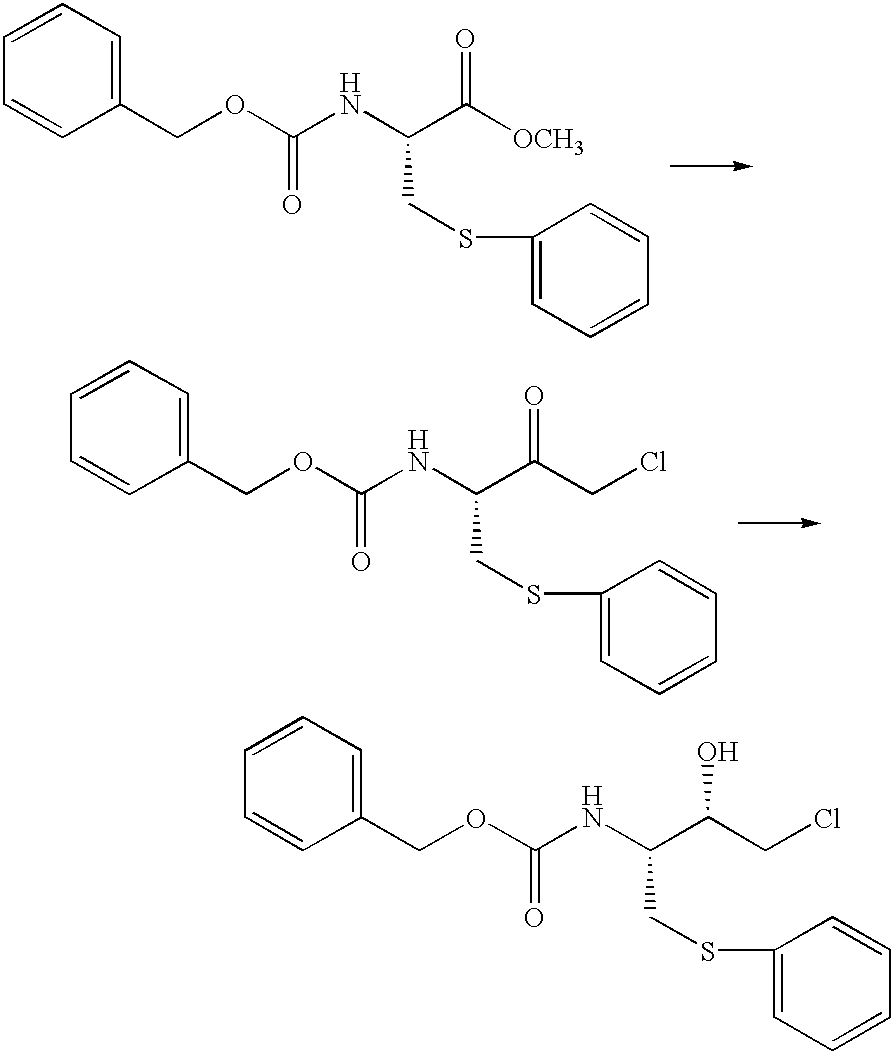Process for producing optically active cysteine derivatives
a technology of optically active cysteine and derivatives, which is applied in the direction of chemical apparatus and processes, chemical production of bulk chemicals, organic chemistry, etc., can solve the problems of easy suppression of decomposition or racemization, decrease in yield, and racemization, so as to achieve the effect of reducing optical purity and favorably preventing racemization
- Summary
- Abstract
- Description
- Claims
- Application Information
AI Technical Summary
Benefits of technology
Problems solved by technology
Method used
Image
Examples
example 1
In a nitrogen atmosphere, 1,500 ml of methanol was added to 300.9 g of N-benzyloxycarbonyl-S-phenyl-L-cysteine and 8.64 g of p-toluenesulfonic acid monohydrate, and the reaction was allowed to proceed under reflux. After 6 hours of reaction, the mixture was cooled to about 40.degree. C., and the pH was adjusted to 5.5 by adding 82 ml of a 5% (by weight) aqueous solution of sodium hydrogen carbonate. Then, the methanol was replaced with toluene at about 40.degree. C., to give 1152.7 g of a toluene-substituted reaction mixture. Then, 200 ml of a 20% (by weight) aqueous solution of sodium chloride was added at 45 to 50.degree. C., and the pH was adjusted to 7.8 with 23 ml of a 5% (by weight) aqueous solution of sodium hydrogen carbonate. After separation of the aqueous phase, the organic phase was washed with two 200-ml portions of a 20% (by weight) aqueous solution of sodium chloride at 45 to 50.degree. C., to give 1130.6 g of a toluene solution, This toluene solution contained 309.8 ...
reference example 1
About 150 g of the reaction mixture after 6 hours of reaction as obtained by the same procedure as in Example 1 and having an N-benzyloxycarbonyl-S-phenyl-L-cysteine methyl ester concentration of 20.5% by weight was adjusted to pH 6, 10, 11 or 12 by adding an aqueous solution of sodium hydrogen carbonate or an aqueous solution of sodium hydroxide, and each mixture was maintained at 40.degree. C. for 1 hour with stirring. Each reaction mixture was subjected to substitution of the methanol for toluene in the same manner as in Example 1 at about 40.degree. C. and 20 ml of a 20% (by weight) aqueous solution of sodium chloride was added to the toluene-substituted reaction mixture. After separation of the aqueous phase, the organic phase was washed with two 20-ml portions of a 20% (by weight) aqueous solution of sodium chloride at 45 to 50.degree. C., and the toluene solution obtained was assayed for the optical purity of N-benzyloxycarbonyl-S-phenyl-L-cysteine methyl ester and the yield ...
example 2
In a nitrogen atmosphere, a solution prepared by admixing 458 mg of concentrated sulfuric acid with 10 ml of methanol was added to 30.03 g of N-benzyloxycarbonyl-S-phenyl-L-cysteine and 140 ml of methanol, and the reaction was allowed to proceed under reflux. After 10 hours of reaction, the mixture was cooled to room temperature and the pH was adjusted to 5.5 by adding 8 ml of a 5% (by weight) aqueous solution of sodium hydrogen carbonate. Then, the methanol was replaced with toluene at about 50.degree. C., to give 116 g of a toluene-substituted reaction mixture. The mixture was then washed with two 40-ml portions of a 10% (by weight) aqueous solution of sodium sulfate at 45 to 50.degree. C. to give 113.5 g of a toluene solution. This toluene solution contained 30.7 g (concentration: 27.1% by weight) of N-benzyloxycarbonyl-S-phenyl-L-cysteine methyl ester; the yield was 98% and the optical purity was 99.6%.
Further, removal of the toluene by distillation was started from 112.0 g of t...
PUM
| Property | Measurement | Unit |
|---|---|---|
| Fraction | aaaaa | aaaaa |
| Fraction | aaaaa | aaaaa |
| Fraction | aaaaa | aaaaa |
Abstract
Description
Claims
Application Information
 Login to View More
Login to View More - R&D
- Intellectual Property
- Life Sciences
- Materials
- Tech Scout
- Unparalleled Data Quality
- Higher Quality Content
- 60% Fewer Hallucinations
Browse by: Latest US Patents, China's latest patents, Technical Efficacy Thesaurus, Application Domain, Technology Topic, Popular Technical Reports.
© 2025 PatSnap. All rights reserved.Legal|Privacy policy|Modern Slavery Act Transparency Statement|Sitemap|About US| Contact US: help@patsnap.com



